
|
Kauffman Stadium was an idea ahead of its time when it opened in 1973. But unlike the next ballpark to boast that claim, Baltimore’s Camden Yards, the home of the Royals was not a trendsetter, which a look at the era it was conceived in proves.
Kauffman Stadium’s began thanks to the voters of the county in which it resides, Jackson, who in 1967 passed a bond issue allowing for its construction as part of an eventual $70 million package that included the Chiefs’ neighboring Arrowhead Stadium. Three decades later the same populace authorized the funds needed for the baseball stadium’s renovation, a $256 million project completed on July 17, 2009 when the Royals’ sparkling new Hall of Fame building was ready for occupancy. So baseball fans worldwide have the Jackson County citizenship to thank for what was, is and will probably always be one of the best ballparks in Major League Baseball, and one that would be inducted into a Ballpark Hall of Fame, if there was such a thing. Long renowned for its picturesque waterfall fountains in the outfield and sleek, sloping curved design, “The K,” as it’s oft referred with affection, was majestic even before it became new again. But when it did, Kauffman Stadium had a sleek exterior to match the slick style that has always been a hallmark of its interior. The previously exposed concrete exterior façade is now fronted by a lengthy building that was added between the two remaining circular ramps (two others were removed during renovations). To add an air of dignity to the structure, it was made of metal sheeting and glass. Attractively illuminated at night, the building holds the Royals’ administrative offices and lion’s share of the stadium’s ticket windows, which were doubled from 23 to 46 following renovations. The K has multiple entry gates but the one designed to be its front door is centered within the three story building, which is where the Home Plate Gate C resides. The walkway outside of it is inlaid with “legacy bricks,” as the team calls them. Made of bluestone, numerous personalized bricks surround much larger ones engraved with great moments in Royals history. Pricing for fans that want to be a part of the legacy starts at $150 for a 4” x 8” brick, the smaller of the two sold. Regardless of where fans enter Kauffman Stadium, they do so on much wider concourses than in the past, as their average width expanded from 24’ to 37’ post-renovation. The concrete they are made of also has a decorative look to it, as both lower and upper concourses have swathes of blue mixed in to offset the speckled grey the remains of the surface is covered with. Similarly colored support beams and interior walls are adorned with flat screen TVs tuned into the game. The most visible addition of the Kauffman Stadium renovations filled in an area that was previously mostly barren. Never boring but definitely not busy or a destination, the territory beyond the outfield fence had been off-limits to fans since the ballpark debuted. But that all changed in 2009 with another debut, this one known as the “Outfield Experience.” Accessed from the concourse that was expanded to wrap completely around the ballpark, the Outfield Experience is choke-full of games and activities for youngsters to enjoy and book-ended by two buildings, the Royals Hall of Fame and Rivals Sports Bar, that older fans will appreciate. Extending from left- to right-center, activities for the younger set include The Little K, a fully turfed mini wiffle ball field where kids try to go deep by clearing a fence that’s 100’ down the lines and 125’ to center. The mini K even has mini light towers for night time play. Sluggerrr, the Royals’ lovable lion mascot, is featured prominently throughout the Outfield Experience. At Sluggerrr's Pitching Mound each “pitcher” gets three throws to “K” a major league hitter that appears in live-action on a big screen. A similar set up is employed at Sluggerrr's Batting Challenge, where hitters in two cages get to take their hacks against a “real” major league pitcher, such as Randy Johnson. At the Sluggerrr's Base Run station there’s only a clock to compete against. It displays in tenths of a seconds the time it takes to run from one base to another, something kids (or anyone for that matter) do along a turf-covered “runway.”
Almost all activities that require physical activity are alongside the back wall of the Outfield Experience. The one exception is a small playground, which is nothing fancy, but the carousel adjacent to it is. Topped with a crown, each of its hand-carved animals is decked out in Royals gear. Also decked out in Royals gear is the lady of liberty herself. Tucked away on the concourse near the team’s Hall of Fame, a replica of the Statue of Liberty is painted in blue and garnished with the team’s logos from torch to toe. Another unlikely, yet unique addition to the outfield concourse is the oversized marble ball that can be rotated upon a cylinder flume of water, which many kids take the time to do from its prominent position in front of Sluggerrr's Base Run. Unlike most things in the Outfield Experience, the ball suspended in water display is free to play with. Only it and the playground don’t require the purchase of tokens, which are a dollar apiece. Two tokens are required for all other activities, except for the Game Lounge, where typical currency lets you play the latest video games. Next to the arcade is the Mainstage, from which live entertainment occasionally emits. When the sun goes down the strings of bulbs hung above the outfield concourse light up, ensuring what’s already a festive atmosphere remains lively. Another area in the outfield that’s always hopping is the Rivals Sports Bar, which is frequented by the 21 & up crowd on a first-come, first-served basis. Fans seeking a good time congregate around the 360-degree bar, while tables in the 150-seat restaurant look out over the playing field from the sports bar’s perch in right field. Tables in the front row can be reserved in advance, but it takes a piggy bank full of tokens ($240+) to do so. Atop the sports bar is the Budweiser sponsored Party Deck, where the well-heeled who like to have fun can party in private. Behind the two-story sports bar and party deck is the Royals All-Star Barbeque. Kansas City is renowned for its barbeque and for years what was served in its ballpark came from Gates, one of two BBQ restaurants of national repute within KC’s confines (Arthur Bryant’s is the other). But Gates’ tenure at The K came to an end in 2009, when the restaurant and team couldn’t agree on financial terms. That led to the Royals opening up a barbeque stand of their own and from it they serve the brisket and burnt ends that are staples of the style of cuisine that Kansas City is most noted for.
Dubbed "the best ballpark feature in America" by Joe Mock, who has scrutinized features at over 300 ballparks, the "water spectacular" commissioned by late Royals owner Ewing Kauffman remains to this day the largest privately funded fountain in the world. A half-million gallons of water cascade down the fountain’s expanse of black walls, flowing from a retaining pool above into two pools below. Between innings nozzles in the middle pool send streams of water high into the sky. At night multi-colored floodlights embedded in the mid-level pool add even more pizzazz to the swaying bursts of water, which makes the aesthetically pleasing spectacle the most dynamic backdrop in baseball. Fans can ooh and aww at the manmade waterfall fountains, which Kauffman spent $1.5 million of his own money to construct, from up close thanks to seats and concourses that opened in 2009. Three sections of seating were added below (outfield box) and above (fountain seats) the fountains in left-center. The seats above the fountains are only sold on game day and upon their opening the Fountain Seats, at $7 apiece, were the cheapest to be found at The K since 2001. Set amidst the fountain seats is the aptly titled Fountain Bar, an open-air adult beverage gathering spot (i.e. bar) topped by a large Miller Lite sign that lists its distance (447’) from home plate on a railing above its highly visible field-facing blue façade. Besides beer, the bar serves up a Royal Rita Margarita. The best addition to the fountain area is free for all to enjoy, courtesy of the Pepsi Party Porch. Found in prime home run territory in right-center field, it’s made up of two levels of walkways that get crowded early, as any fan with a ticket can enjoy the unique vantage point afforded on a first-come, first-served basis. Both levels have wooden planks that will hold any food or drink a fan brings into the area. The upper walkway passes just a handful of feet from where water crashes into a retaining pool and just the slightest of breezes ensures fans standing on that level enjoy refreshment of a different kind. The entire waterfall display is framed on each side by a diminutive amount of shrubbery, which is in much greater supply behind the batter’s eye in straightaway center.
Kauffman Stadium has three levels of seating in its main grandstand. All are filled with dark blue seats. The lower level extends slightly beyond each foul pole and includes four field-level dugout suites, named for their close proximity to each dugout, plus six sections of Crown Club seats behind home plate, which are the most expensive individual seats in the house. The most famous seat in the house is padded and painted red to honor its long-time former occupant, baseball legend and ambassador Buck O'Neil. Since 2007 the Buck O'Neil Legacy Seat has been filled by a member of the community that “embodies an aspect of Buck's spirit.” It’s located in Section 127, Seat 9, Row C. Complete with retractable glass and IP-connected HDTVs, the ritzy Diamond Club is at the top of the lower bowl. Beneath it are four rows of Diamond Club Boxes. The seating there is made up of wooden chairs and countertops. The second level is the smallest of the three and contains just loge and signature club boxes. The upper level tapers as it nears its ending point just inside of the foul poles. Known as the view level, the name is appropriate. Everything inside of and beyond the ballpark is visible from the 39 sections that comprise this 400-level. Two supersized portals can be seen in the upper deck above first and third base, in sections 412 and 428. It is near their entrances that elevators from the lower (and street) level drop fans off. Because the top deck tapers the stadium’s roof doesn’t fully extend its length, yet banks of light towers are able to extend two sections beyond the roof’s end on each side thanks to the continuation of the angled beams that support the roof. Those beams and the rectangular light towers they support give the stadium a distinctive appearance for fans that approach The K by car, which is the mode of transportation made necessary due to the stadium’s somewhat remote location. Once upon a time, the primary view from the view level was the grass covered hillside leading up to I-70, where cars can still be seen zooming east and west. But the canvas of green grass doesn’t dominate as it did before 2009, when the Outfield Experience finally fully enclosed the stadium and joined the CrownVision scoreboard and waterfall fountains as focal points. The most noticeable building looming on the horizon is the headquarters of the Fellowship of Christian Athletes, which is perched on the tree-covered hill that rises above I-70 in left field. Much smaller trees make up a portion of the landscaping within the stadium proper. Two statues once outside of the stadium were brought inside for 2009, and the bronze sculptures of George Brett and Frank White now reside upon the outfield concourse in right-center, where a statue of Dick Howser joined them on July 18. Text on all four sides of each statue’s base tell about the careers of the only three men to have their number retired by the Royals. On June 7, 1986 the Royals established a team Hall of Fame and in 2009 it was finally given a permanent and prominent position within Kauffman Stadium. Located in left field, the Royals Hall of Fame admits groups of up to 40 people in 15-minute increments from the time the ballpark’s gates open until the top of the 8th inning. The Hall contains artifacts and exhibits galore about great players and moments in Kansas City baseball history and includes displays dedicated to the Blues and Monarchs, the city’s former minor and Negro league teams. All of the additions to Kauffman Stadium did result in one ironic subtraction, as over 2,500 seats were removed during renovations, reducing the ballpark’s capacity from 40,775 to 38,177, although all of those seats are rarely called into duty in one night. After finishing next to last in American League attendance seven times, the Royals finally hit rock bottom in 2008 thanks to the surge of the Tampa Bay Rays, the previously perennial cellar dwellers in the AL East and in the AL's turnstile count. Whereas the Rays improved their position at the box office by improving their standing in the standings, the Royals’ rebuilding process is taking much longer than the 33+ months it took to work over their stadium. After finishing in last place more often than not in the first decade of the 21st century, it’s fitting that Kauffman’s 8th inning sing-a-long song is “Friends in Low Places” by Garth Brooks, the Midwestern born country star who participated in the Royals’ 2004 spring training camp to promote his Touch 'Em All Foundation. While the on-field product may be one of the worst in the league, the stadium that the Royals take the field on is one of the best in the Majors. Before and after renovations, that’s the one thing that remained unchanged.
Location and ParkingKauffman Stadium is part of the Truman Sports Complex, which houses the homes of the Royals and the NFL's Chiefs, who play at Arrowhead Stadium. Located five miles east of downtown Kansas City and near the I-435 interchange, the complex is below and a mere handful of paces south of I-70. The Interstate is so close to The K that it's a highly visible part of the backdrop for any fan sitting in the ballpark's upper deck. Since Kauffman Stadium is in the complex's foreground, relative to I-70, it can't be missed by any car driving along the East-West route, which was the country's first Interstate project when it was signed into law in 1956. A dozen years later, ground was broken for the nation's first multi-stadium complex. Besides the two stadiums, not much has been built in the immediate vicinity since. Founded in 1838 as the "Town of Kansas," Kansas City is Missouri's biggest and is also a part of the largest metropolitan area in Kansas. The city first originated at the confluence of the Missouri and Kansas rivers and straddles the borders of those two states. The Missouri Welcome Center is on the same exit as the ballpark, and to get to both you exit I-70 at the Blue Ridge Cutoff (exit #9). The two stadiums at the Truman Sports Complex are engulfed in a sea of paved parking. There are enough spaces for over 19,000 vehicles, although the majority of them only get used by Chiefs fans, who have sold out 79,451-seat Arrowhead Stadium for every game since 1991. For baseball games, only the West and East lots adjacent to Kauffman Stadium are open. Fans arriving for Royals games enter the complex through toll booth-style manned gates, where attendants collect payment and flag bearers then guide vehicles to a resting place that is priced moderately considering the proximity to the ballpark. Although the cost has risen from $6 in 2003 to $9 in 2009, that is still much cheaper than the inflated big league norm.
The Royals Hall of FameIn the words of the team, "The Royals Hall of Fame is an education and entertainment venue that blends the timelessness of a museum with the sheer fun of the ballpark." And that is an apt description of the 6,800-square-foot building that opened on July 17, 2009. Its completion marked the official end to Kauffman Stadium's renovations. Located in left field, near Gate A, and designed to be the signature feature of the Outfield Experience, the Royals Hall of Fame (RHoF for short) is a scaled-down version of the thoroughness you'd find in Cooperstown, from where many exhibits are on loan, that is dedicated to chronicling Kansas City's baseball history, which it does from 1884 to the present. As such, putting "Royals" in the Hall's name is somewhat of a misnomer, as the Blues, Monarchs and Athletics are all given their due, although the majority of exhibits are Royal related. Open year-round and always at 10 AM (but just on Tuesday/Thursday/Saturday during the off-season), the first thing patrons of the RHoF will see upon entrance is a 17' x 70' wall made of ash that is inscribed with newspaper headlines and briefs about Kansas City's various home teams. Placed beneath the headline "Royals head for first World Series" are three lockers that contain jerseys from George Brett, Dick Howser and Frank White, the only players in Royals' history to have their number retired by the team. From the Clubhouse Lobby entrance visitors are taken to the Dugout Theater, where they watch a 15-minute multimedia presentation from a replica of the Royals’ dugout on a 36’ x 9’ movie screen. The dugout area has two rows of wooden benches and at a far end of the front one sits a life-size statue of Kansas City's legendary Buck O'Neil. The visual learning experience continues inside the Hall's largest gallery, Royals Way, where exhibits tell the story of Kansas City’s current team plus many of the great moments that have occurred in the two ballparks they have used. One of the more interesting exhibits is about how the Royals came to be. Not the team, but the name. "Kansas City's new baseball team should be called the 'Royals' because of Missouri's billion dollar livestock income, Kansas City's position as the nation's leading stocker and feeder market and the nationally known American Royal parade and pageant," wrote Sanford Porte on March 10, 1968 in his Name the Team entry submission. Porte’s letter ended up naming the team and a copy of it is on display above a half-dozen discarded logos that artists from Kansas City-based Hallmark created for the team as it searched for a way to illustrate its new-found identity. The static exhibits are fascinating but the Hall’s interactive exhibits are fabulous. At two of them fans get an opportunity to do something that all baseball aficionados dream of: design a ballpark and take to the airwaves. Using a touch-screen computer at the "Build Your Own K" demo, fans can customize Kauffman Stadium to their specifications and have the finished design e-mailed to them. From a radio booth overlooking the playing field fans can “Make the Call” of memorable moments in Royals' history and then relive their moment at the microphone over and over again by e-mailing the audio clip to themselves. One of the chief reasons any Hall of Fame exists is to honor those who have achieved excellence in any given field. Those who have excelled on Kansas City’s field of play are remembered in the Hall of Fame Gallery. The Royals began honoring their own on June 7, 1986, when Amos Otis and Steve Busby became the first inductees into the Royals Hall of Fame. When the building with the same name opened 23 years later, 21 additional members had joined them. An artist’s rendering of each inductee accompanies the information contained on the 23 plaques in the gallery. The two most prominent members of the team’s Hall on display in the team’s Hall are George Brett and Frank White, each of who are celebrated in the Crowning Moments room along with the seven championship trophies the Royals have earned, the highlight of which is the 1985 World Series trophy. White was beloved because of his glove and won the Gold Glove Award eight times for his prowess at second base. Since he gave each of his awards to his children, the eight Gold Gloves you see at White's exhibit aren’t the originals; the Royals paid Rawlings to reproduce them for the RHoF and that's what is on display. The bat displayed within the Brett tribute is the history-making original he used for his 3,000th hit. That bat, along with the ball it hit, is encased in glass within the 3,154 baseballs it took to make a 9½’ tall number 5, which was Brett’s uniform number. The 3,154 baseballs represent the amount of hits he amassed over his career and took 100 hours to thread together. It won’t take you that long to enjoy the Royals Hall of Fame but diehard KC fans and baseball history buffs could easily spend more than an hour in the building, which also contains five suites and a banquet room, and the best part is it’s free to enjoy with a game ticket. On game day fans are admitted up to 40 at a time every 15 minutes from the moment the stadium’s gates open through the top of the eighth inning. Hours and admission prices for all other days are posted on the Royals’ Web site.
Ballpark HistoryThe Missouri General Assembly passed legislation authorizing the formation of the Jackson County Sports Complex Authority (JCSCA) in 1965 and when its first five commissioners began work the following year their primary focus was on planning and securing funding for a new stadium that the Kansas City A’s and Chiefs could call home. The JCSCA initially, and briefly, considered following the prevailing trend of the time, which was to build one stadium in which both baseball and football would be played, but that idea was scrapped for an ambitious twin stadium plan that was unveiled by the authority on May 3, 1967.
To raise those funds a bond issue election would need to be held. For that to happen a mere 3,500 signatures on petitions calling for one needed to be collected and when the JCSCA turned them in to the county court the dual stadium sports complex became the key component of a $102 million bond issue election scheduled for June 27, 1967. Jackson County voters approved the bond measure but that didn’t prevent Charlie Finley from moving his A’s to Oakland shortly thereafter. Finley was lured west by the one-year old Oakland-Alameda County Coliseum, which meant Kansas City no longer had a team to play in its yet to be built baseball stadium. That changed in a hurry when, under pressure from US Senator Stuart Symington, American League owners met on October 19 and agreed to fast track an expansion franchise to replace the recently departed A’s and become the tenant needed to satisfy the bonds passed for the baseball portion of the new complex. For the first time since 1883 professional baseball would be absent from Kansas City in 1968, but on July 11th of that year construction began on the Harry S. Truman Sports Complex, named after the locally born and raised 33rd President of the United States. Following a one-year hiatus from America’s national pastime the Royals would put Kansas City back on the major league map in 1969 and the Athletics’ former home, Municipal Stadium, back into temporary use. Royals owner Ewing Kauffman was the man responsible for revitalizing a team in the American League’s smallest market and he aided the Kansas City architectural firm of Kivett and Myers in designing Municipal Stadium's replacement and what remains to this day one of baseball’s signature ballparks. But despite getting most of the credit, Kivett and Myers actually implemented the design of another architect, Denever-based Charles Deaton, who used the new baseball-only parks in Anaheim and Los Angeles as his models. That explains why the original main grandstand in Kansas City’s formed a rounded acute angle just past the foul poles. As for Kauffman, he chipped in a few million from his fortune, which was made in pharmaceuticals, so his team’s stadium would have the two distinguishing features for which it has always been known: the waterfall fountain display and crown-shaped scoreboard. The fountains were one-of-a-kind and the scoreboard the largest of its kind when the stadium finally opened in 1973, a year late due to a construction strike. Standing 12 stories high, the scoreboard was designed in the shape of the Royals’ crown logo and had a 40’ wide by 60’ tall main screen that was capable of showing player portraits and other animated images thanks to 16,320 bulbs and $2 million of Mr. K’s money. Despite the Royals owner’s generosity, the final cost for the entire sports complex ended up being $27 million over budget. The $70 million price tag didn’t include the roof-on-rails idea, which was a casualty of the escalating costs. On August 12, 1972, the Chiefs played the first game in the Truman Sports Complex, defeating the St. Louis Cardinals 24–14 in a pre-season game at Arrowhead Stadium. Royals Stadium’s first game on April 10, 1973 was one that counted and Kansas City fans again went home happy, and to get warm, following the Royals’ 12-1 win over the Texas Rangers on a 39-degree night before 39,464 fans packed into maroon, gold and orange seats. That first game, and every one for 22 seasons after it, was played on artificial turf because Ewing Kauffman reasoned it was better for gate receipts. AstroTurf was chosen as the stadium’s playing surface because less games could be rained out on fake grass than real grass, a choice Kauffman made in deference to a Royals fan base than extended well into Kansas and beyond (fans driving from distant destinations were less likely to do so if they felt the game would be PPD by rain). The Royals finally got rid of the turf in 1995, installing grass and a super duper drainage system for it in their stadium, which by then had been renamed in Ewing Kauffman’s honor. Royals Stadium was officially rededicated as Kauffman Stadium on July 2, 1993. Thirty days later Kauffman died from bone cancer at the age of 76. The biggest enhancement added to the stadium during Kauffman’s lifetime was 30’ x 40’ in size and installed behind the outfield wall in left-center, where a Sony JumboTron was erected in 1990. The stadium started to become more upscale in 1999 with the addition of Dugout Suites and the Crown Club Seats behind home plate. By the time the 2000 season began all seats in the stadium had been replaced with the current dark blue ones. But the biggest changes were yet to come.
As part of the deal both teams contributed $25 million, bringing the total renovation cost to $575 million.
The JCSCA considered that price to be a bargain, as they later noted in their October 2007 issue of the Truman Sports Complex Renovation Newsletter: Both the Royals and Chiefs had agreed to 25-year lease extensions on January 25, 2006 that went into effect when the sales tax referendum passed 69 days later, with approval for the measure granted by 53% of the 93,662 ballots cast. Technically, Jackson County voters batted .500 for the teams, as they voted against a separate tax referendum that would have finally made the rolling roof that was planned four decades earlier a reality. The $170 million roof referendum was voted down after 52% of 93,451 ballots were cast against the proposition that was simply referred to as "Question 2," which if passed would have primarily taxed products Jackson County businesses bought from outside of Missouri. The irony of the two question referendum was that Jackson County residents voted to shield private businesses within their county from paying an additional tax, yet levied one against themselves to benefit two such private entities in the Royals and Chiefs. Another private local enterprise that benefited greatly from the influx of tax cash was Populous, the dominant player in the sports stadium design industry. Better known by its abbreviated pre-2009 name, HOK Sport, the renowned KC-based architectural firm can trace its roots, and success, all the way back to the building of the Truman Sports Complex. The architect on record then, Kivett and Myers, was bought out by HNTB in 1975. Eight years later some of HNTB's architects were hired by HOK to form their sports stadium division and HOK Sport Venue Event would forever change the purpose and appearance of ballparks following their groundbreaking work on Camden Yards in Baltimore in the early 1990s. After a management buyout in 2009 Populous was born, completing an evolution that was always headquartered in Kansas City. It was only natural that the hometown heavyweight was awarded the renovation design contract on their hometown ballpark, which become one of the first to list the Populous brand on a dedication plaque. Before that happened construction had to commence and that process began with a ceremonial groundbreaking at home plate on October 3, 2007. By then the primary contractor contract had been awarded to a joint venture between the Hunt and Walton Construction groups. The JCSCA had a total of 40 additional bid packages to award and they were under a directive to ensure that 30% of the work was performed by minority (22%) and women-owned (8%) businesses and contractors. When all was said and done, 32% of the workforce overseen by the Hunt-Walton venture was comprised of minorities and women. They completed their work on Kauffman Stadium on time and on budget, although the Royals eventually chipped in another $6 million to further enhance club seating and administration areas, bringing their total commitment to $31 million and pushing The K’s final renovation cost to $256 million. The renovations were completed in phases over 33½ months. A new CrownVision scoreboard replaced the original one to finish the first portion of the renovations, which were completed by Opening Day 2008 and included the reconfiguration of the bullpens and removal of the JumboTron. Thirty-six years to the day that the stadium opened, the “new” Kauffman Stadium was unveiled on April 10, 2009 when the Royals played host to the Yankees before 38,098 spectators on a 53-degree Friday afternoon. The only thing yet to be completed by then was the Royals Hall of Fame, which would open the day after the All-Star break, on July 17. The Royals lost to the Yankees 4-1 on day #1 of The New K, which had new seats and a horde of activities in the outfield, all near the park’s famed waterfall fountains, but lost enough seating elsewhere to accommodate for wider concourses and big-bucks premium areas that total capacity was reduced by 2,598. While it was redesigned to hold fewer fans (38,177), Kauffman Stadium officially reopened (although it never closed) with the highest ratio of concession stands and toilets per fan in the majors, an impressive statistic considering that it was Major League Baseball's sixth oldest ballpark in 2009, when just two classics (Fenway, Wrigley), its two models (Angel and Dodger Stadiums) and the venue (Oakland Coliseum) that caused its intended tenant to bolt were the only older stadiums still in use.
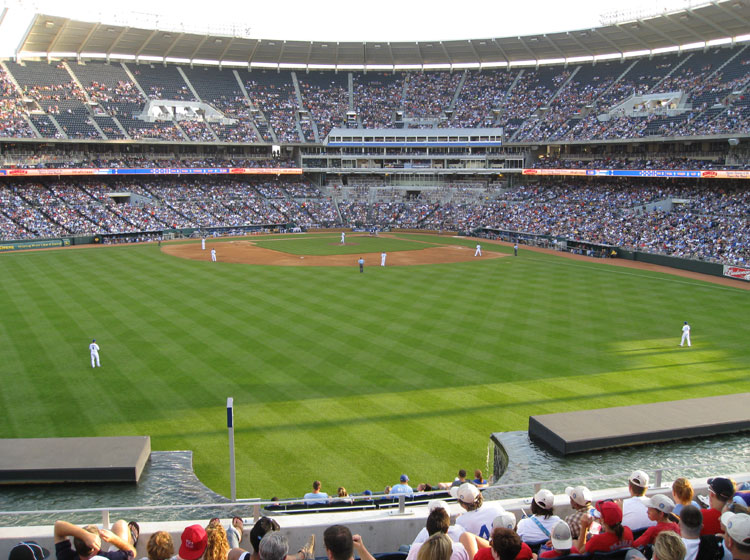
Kauffman Stadium Facts, Figures & Footnotes
| |||||||||||||||||||||||||||||||||||||
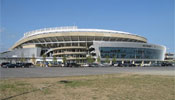
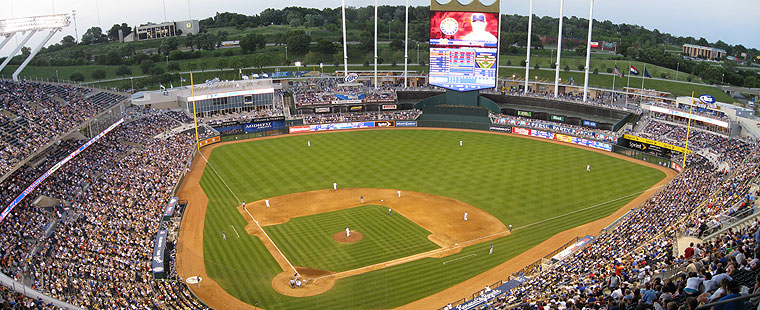
 Since it was invented miniature golf has been a popular family-friendly diversion. Ditto for the five hole course installed at The K, which features baseball-themed obstacles.
Since it was invented miniature golf has been a popular family-friendly diversion. Ditto for the five hole course installed at The K, which features baseball-themed obstacles.
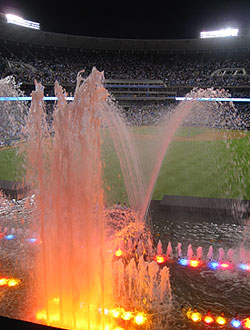 Barbeque meat and sauce aside, Kansas City’s true civic point of pride is its fountains. The city has been building them since 1899 and today boasts of more than 200. The only city in the world with more is Rome. But it’s Kansas City that is known as the “City of Fountains,” which makes it fitting that Kauffman Stadium’s signature and most mesmerizing feature is its 322 feet of continuous waterfalls and fountains.
Barbeque meat and sauce aside, Kansas City’s true civic point of pride is its fountains. The city has been building them since 1899 and today boasts of more than 200. The only city in the world with more is Rome. But it’s Kansas City that is known as the “City of Fountains,” which makes it fitting that Kauffman Stadium’s signature and most mesmerizing feature is its 322 feet of continuous waterfalls and fountains.
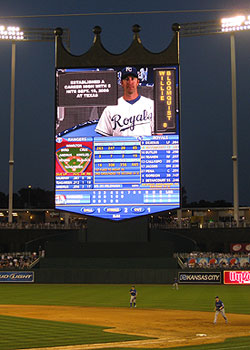 Towering above the hitter’s backdrop is the crown-shaped scoreboard, a massive structure of which anybody entering the stadium’s grandstand becomes immediately aware of. Standing 104 feet tall and measuring 84 feet wide, the high-definition CrownVision scoreboard is more than twice the size of the 12-story original. The 8,736 square foot behemoth cost $8.3 million and when it was unveiled on Opening Day of 2008 it was the largest high-def LED display in the world. It shows enough statistics and information to make any SABR member happy and a staff of 17 is needed to operate it, along with the LED ribbon boards that ring the lower façade of the loge level.
Towering above the hitter’s backdrop is the crown-shaped scoreboard, a massive structure of which anybody entering the stadium’s grandstand becomes immediately aware of. Standing 104 feet tall and measuring 84 feet wide, the high-definition CrownVision scoreboard is more than twice the size of the 12-story original. The 8,736 square foot behemoth cost $8.3 million and when it was unveiled on Opening Day of 2008 it was the largest high-def LED display in the world. It shows enough statistics and information to make any SABR member happy and a staff of 17 is needed to operate it, along with the LED ribbon boards that ring the lower façade of the loge level.

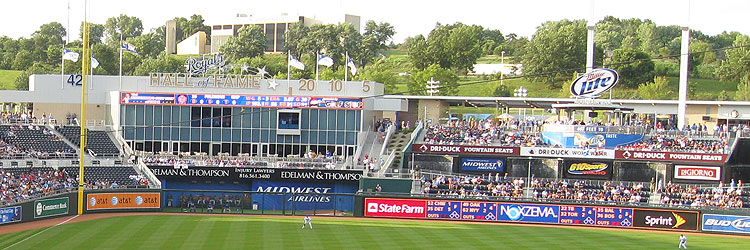

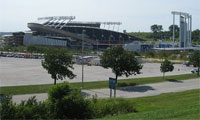
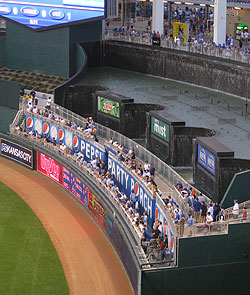 On April 4, 2006 the voters of Jackson County once again came through for the Royals and Chiefs by approving a 3/8-cent sales tax increase to fund $525 million worth of renovations to the Truman Sports Complex’s stadiums. The Royals’ slice of public assistance money amounted to $225 million; the Chiefs received $300 million for their much bigger stadium.
On April 4, 2006 the voters of Jackson County once again came through for the Royals and Chiefs by approving a 3/8-cent sales tax increase to fund $525 million worth of renovations to the Truman Sports Complex’s stadiums. The Royals’ slice of public assistance money amounted to $225 million; the Chiefs received $300 million for their much bigger stadium.

